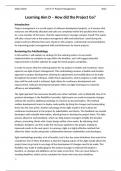Essay
Unit 9 - IT Project Management Assignment 3 (Learning Aim D) DISTINCTION
- Course
- Institution
UNIT 9 IT PROJECT MANAGEMENT, COVERS ALL CRITERIA DISTINCTION LEVEL ASSIGNMENT LEARNING AIM D - Undertake the closure of a project by reflecting on the success of personal performance and the project outcome. D.P8 - Explain how project management skills were used in the management of an IT...
[Show more]



